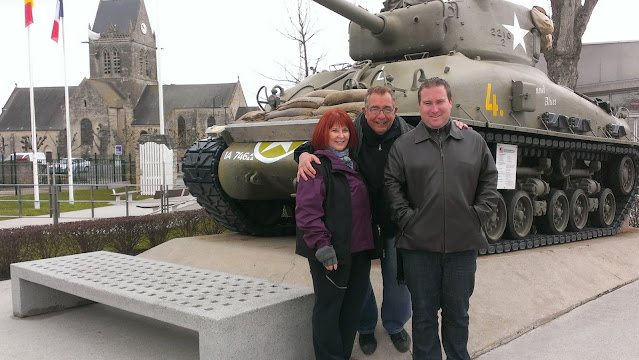
Father/son visitors to Normandy walk the hallowed sands of Omaha Beach on a rainy spring day. The three-part monument/sculpture,
“Les Braves,” is by Anilore Banon
By Thomas Shess--There are so many routes American tourists can take to fulfill a melancholy journey to visit the D-Day beaches and surrounding villages of Normandy. Two grown sons, my wife and a retired editor launched ourselves from San Diego via British Airways (on American Airlines equipment) to Madrid, where we reconnected with the Spanish Capitol. A few years earlier, we visited Madrid where our youngest son was attending year long studies there.
From the heart of Spain, we boarded a bullet train from Madrid’s amazing combo of train station and botanical garden to explore the always intriguing nooks and crannies of Barcelona. We stayed at a small hotel on Las Ramblas. After several days there we hopped a non-bullet train from the heart of Catalonia to Paris. We learned the overnighter was going to be discontinued when the new bullet train route was completed. We were fortunate to book one of the final journeys of the old train as we click-clacked our way to a morning arrival in Paris. But not before indulging in first-class complete with white tablecloths, tasty menu items, enjoyable libations and priceless conversations with the family. Our tux-ed waiters didn’t blink an eye knowing this train was on its way to the junkyard. Cie-la-Vie.
Via rail from Gare du Nord in Paris, we boarded a commuter train to the fascinating village of Bayeux. The train was loud—not so much from human noise but from the ancient equipment we were riding on. Typical Americans we just talked louder. Our car was filled with business types—all well-dressed. They endured us. Occasionally, they’d peeks over their newspapers to see the source of the chatter.
In advance of our tour via the Internet. we hired Danielle, a French tour guide (who lived for a short time in San Diego). She took us to the many sites we read about in history books. Her diligence in making sure we didn’t miss any major landmarks made our eyes blur. And, she fixed us lunch as part of the deal at the home of her son. You may reach Danielle via her son at American DDay Tours: trevor.standefer@gmail.com
Sadly, it rained during our D-Day visit (we based our stay at the Churchill Hotel in nearby Bayeux) but it did not diminish the feeling of pride who fought bravely on the beaches starting on June 6, 1944.We were told by guide Danielle that the French in Normandy are fond of Americans (more so than the average cab driver in Paris). We experienced that warmth as we first entered Bayeux. Being the last of our brood to exit the train, I felt a hand placed on my shoulder. I turned to see a nice smile from the older man seated across the aisle from us. He had been reading something by Sartre. Now on the station platform, he asked in English if we were visiting the D-day beaches. Yes, we nodded explaining arrived to salute our dads, who in 1944 went through Omaha Beach en route to the battlefronts.
Mrs. Tourist’s father, a tank commander under General Patton, earned a Silver Star for gallantry as his unit liberated Belgian villages. To this day my wife and I wonder if my father was one of the soldiers who marched next to the tanks as they battled from the beaches to eventual victory.
Our fellow train rider smiled and thanked us letting us know that his generation still owes a huge debt of gratitude to the young boisterous American soldiers who fought shoulder-to-shoulder with the French to free the world of Nazism and brutal authoritarianism.
I offered a handshake.
He responded with a hug and a pat on my shoulder as he exited the train.
I accepted his over-the-shoulder glance back to us “Merci, Yanks” on behalf of the young lieutenant, who survived the brutal war and became my father-in-law.
I was proud that the encounter was witnessed by my sons. I hope it showed a younger generation that it is my firm belief the French would be first in line to aid our country if God forbid, we needed the help, again (read: Amer. Revolution).
 |
| The delightful and delicious Michelin-starred La Rapiere Restaurant in Bayeux. |
Leaving behind memories of rainy Normandy and a delicious meal at the Swordsman Restaurant (read: La Rapiere Restaurant in Bayeux, above) we railed back to Paris to transfer to the next train North to Belgium.
On our next trip to Normandy, we will add another day or two in the Bayeux-Caen region by cutting a day in Paris. How can anyone cut a day in Paris? It wasn’t our first trip there and we’re hoping not our last.
MORE IMAGES FROM NORMANDY FRANCE.
 |
On the right, U.S. Army brave hearts march up a hill behind a German bunker overlooking the D-Day landing zone on Omaha Beach on 6-6-44. On the left, young people hike past the same bunker. |
 |
| DDay photo of a downed plane on Juno Beach in Saint-Aubin-sur-Mer, and on the left, the same beach as it appears today. |



No comments:
Post a Comment